ACC621 - Auditing Practice: Risk Assessment & Audit Procedures
VerifiedAdded on 2023/06/04
|12
|2831
|340
Report
AI Summary
This report addresses several key issues in auditing practice, specifically in the context of planning an audit for a small client, Coral Enterprises. It begins by evaluating the appropriateness of the preliminary materiality assessment, determining that the audit partner's suggestion is too high and would require adjustments to the audit budget and procedures. An analytical review, using trend analysis, identifies four income statement accounts at risk of material misstatement: sales, interest income, cost of sales, and repairs and maintenance. For each of these accounts, the report discusses the specific assertions at risk and proposes appropriate audit procedures to address those risks. Finally, it refutes the audit partner's suggestion to disregard fraud risk, emphasizing the auditor's responsibility to consider and address potential fraud risks, regardless of perceived trustworthiness. The report uses the provided trial balance data to support its analysis and recommendations.
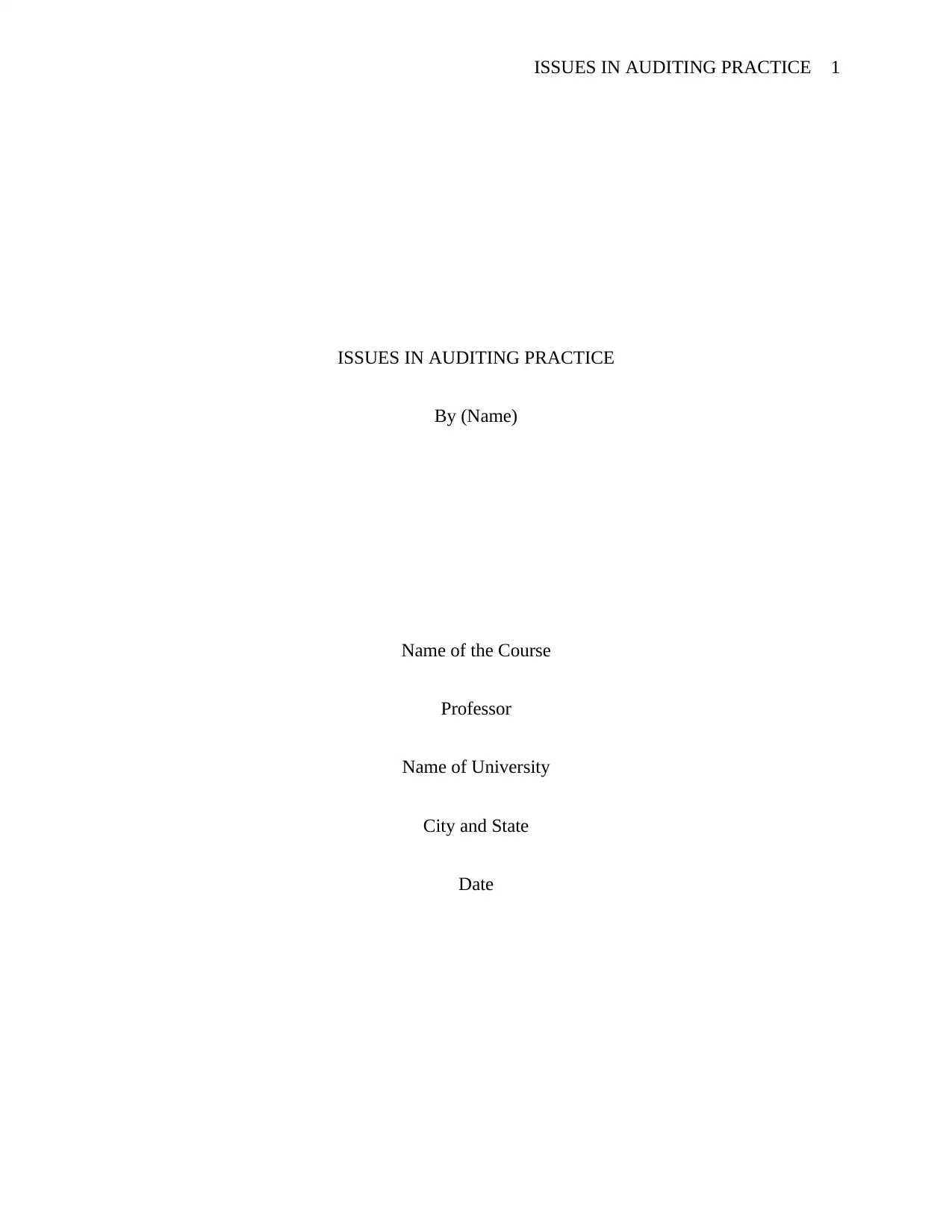
ISSUES IN AUDITING PRACTICE 1
ISSUES IN AUDITING PRACTICE
By (Name)
Name of the Course
Professor
Name of University
City and State
Date
ISSUES IN AUDITING PRACTICE
By (Name)
Name of the Course
Professor
Name of University
City and State
Date
Paraphrase This Document
Need a fresh take? Get an instant paraphrase of this document with our AI Paraphraser
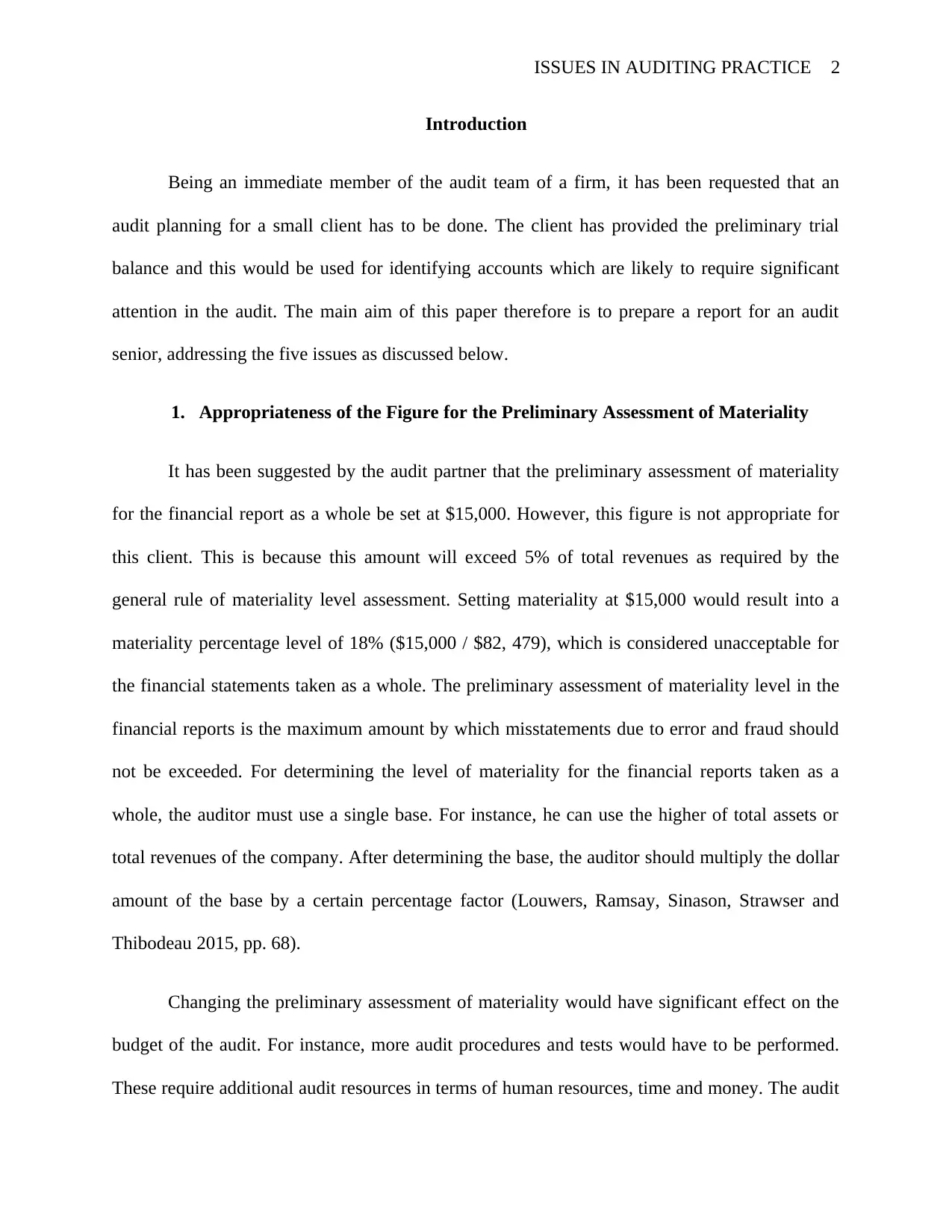
ISSUES IN AUDITING PRACTICE 2
Introduction
Being an immediate member of the audit team of a firm, it has been requested that an
audit planning for a small client has to be done. The client has provided the preliminary trial
balance and this would be used for identifying accounts which are likely to require significant
attention in the audit. The main aim of this paper therefore is to prepare a report for an audit
senior, addressing the five issues as discussed below.
1. Appropriateness of the Figure for the Preliminary Assessment of Materiality
It has been suggested by the audit partner that the preliminary assessment of materiality
for the financial report as a whole be set at $15,000. However, this figure is not appropriate for
this client. This is because this amount will exceed 5% of total revenues as required by the
general rule of materiality level assessment. Setting materiality at $15,000 would result into a
materiality percentage level of 18% ($15,000 / $82, 479), which is considered unacceptable for
the financial statements taken as a whole. The preliminary assessment of materiality level in the
financial reports is the maximum amount by which misstatements due to error and fraud should
not be exceeded. For determining the level of materiality for the financial reports taken as a
whole, the auditor must use a single base. For instance, he can use the higher of total assets or
total revenues of the company. After determining the base, the auditor should multiply the dollar
amount of the base by a certain percentage factor (Louwers, Ramsay, Sinason, Strawser and
Thibodeau 2015, pp. 68).
Changing the preliminary assessment of materiality would have significant effect on the
budget of the audit. For instance, more audit procedures and tests would have to be performed.
These require additional audit resources in terms of human resources, time and money. The audit
Introduction
Being an immediate member of the audit team of a firm, it has been requested that an
audit planning for a small client has to be done. The client has provided the preliminary trial
balance and this would be used for identifying accounts which are likely to require significant
attention in the audit. The main aim of this paper therefore is to prepare a report for an audit
senior, addressing the five issues as discussed below.
1. Appropriateness of the Figure for the Preliminary Assessment of Materiality
It has been suggested by the audit partner that the preliminary assessment of materiality
for the financial report as a whole be set at $15,000. However, this figure is not appropriate for
this client. This is because this amount will exceed 5% of total revenues as required by the
general rule of materiality level assessment. Setting materiality at $15,000 would result into a
materiality percentage level of 18% ($15,000 / $82, 479), which is considered unacceptable for
the financial statements taken as a whole. The preliminary assessment of materiality level in the
financial reports is the maximum amount by which misstatements due to error and fraud should
not be exceeded. For determining the level of materiality for the financial reports taken as a
whole, the auditor must use a single base. For instance, he can use the higher of total assets or
total revenues of the company. After determining the base, the auditor should multiply the dollar
amount of the base by a certain percentage factor (Louwers, Ramsay, Sinason, Strawser and
Thibodeau 2015, pp. 68).
Changing the preliminary assessment of materiality would have significant effect on the
budget of the audit. For instance, more audit procedures and tests would have to be performed.
These require additional audit resources in terms of human resources, time and money. The audit
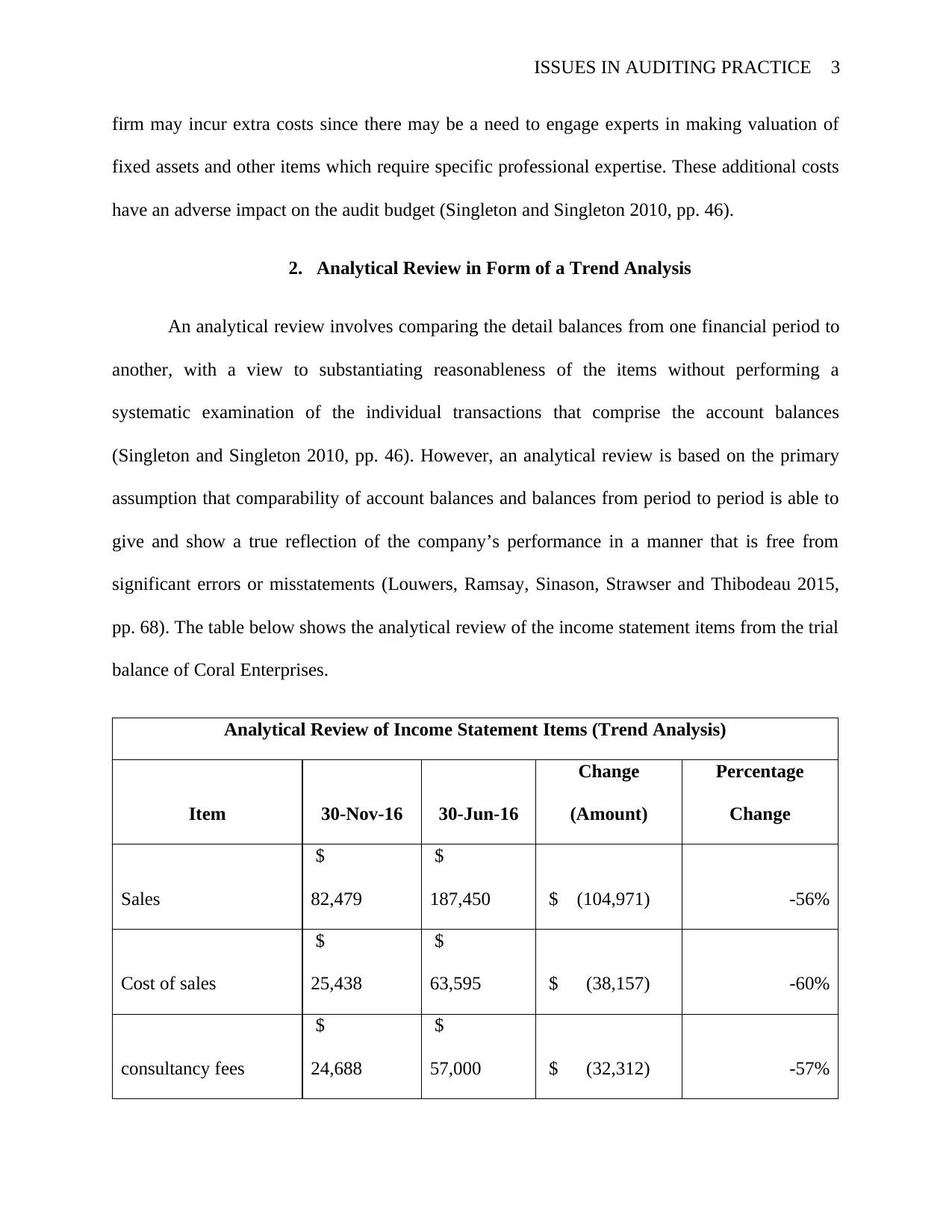
ISSUES IN AUDITING PRACTICE 3
firm may incur extra costs since there may be a need to engage experts in making valuation of
fixed assets and other items which require specific professional expertise. These additional costs
have an adverse impact on the audit budget (Singleton and Singleton 2010, pp. 46).
2. Analytical Review in Form of a Trend Analysis
An analytical review involves comparing the detail balances from one financial period to
another, with a view to substantiating reasonableness of the items without performing a
systematic examination of the individual transactions that comprise the account balances
(Singleton and Singleton 2010, pp. 46). However, an analytical review is based on the primary
assumption that comparability of account balances and balances from period to period is able to
give and show a true reflection of the company’s performance in a manner that is free from
significant errors or misstatements (Louwers, Ramsay, Sinason, Strawser and Thibodeau 2015,
pp. 68). The table below shows the analytical review of the income statement items from the trial
balance of Coral Enterprises.
Analytical Review of Income Statement Items (Trend Analysis)
Item 30-Nov-16 30-Jun-16
Change
(Amount)
Percentage
Change
Sales
$
82,479
$
187,450 $ (104,971) -56%
Cost of sales
$
25,438
$
63,595 $ (38,157) -60%
consultancy fees
$
24,688
$
57,000 $ (32,312) -57%
firm may incur extra costs since there may be a need to engage experts in making valuation of
fixed assets and other items which require specific professional expertise. These additional costs
have an adverse impact on the audit budget (Singleton and Singleton 2010, pp. 46).
2. Analytical Review in Form of a Trend Analysis
An analytical review involves comparing the detail balances from one financial period to
another, with a view to substantiating reasonableness of the items without performing a
systematic examination of the individual transactions that comprise the account balances
(Singleton and Singleton 2010, pp. 46). However, an analytical review is based on the primary
assumption that comparability of account balances and balances from period to period is able to
give and show a true reflection of the company’s performance in a manner that is free from
significant errors or misstatements (Louwers, Ramsay, Sinason, Strawser and Thibodeau 2015,
pp. 68). The table below shows the analytical review of the income statement items from the trial
balance of Coral Enterprises.
Analytical Review of Income Statement Items (Trend Analysis)
Item 30-Nov-16 30-Jun-16
Change
(Amount)
Percentage
Change
Sales
$
82,479
$
187,450 $ (104,971) -56%
Cost of sales
$
25,438
$
63,595 $ (38,157) -60%
consultancy fees
$
24,688
$
57,000 $ (32,312) -57%
⊘ This is a preview!⊘
Do you want full access?
Subscribe today to unlock all pages.

Trusted by 1+ million students worldwide
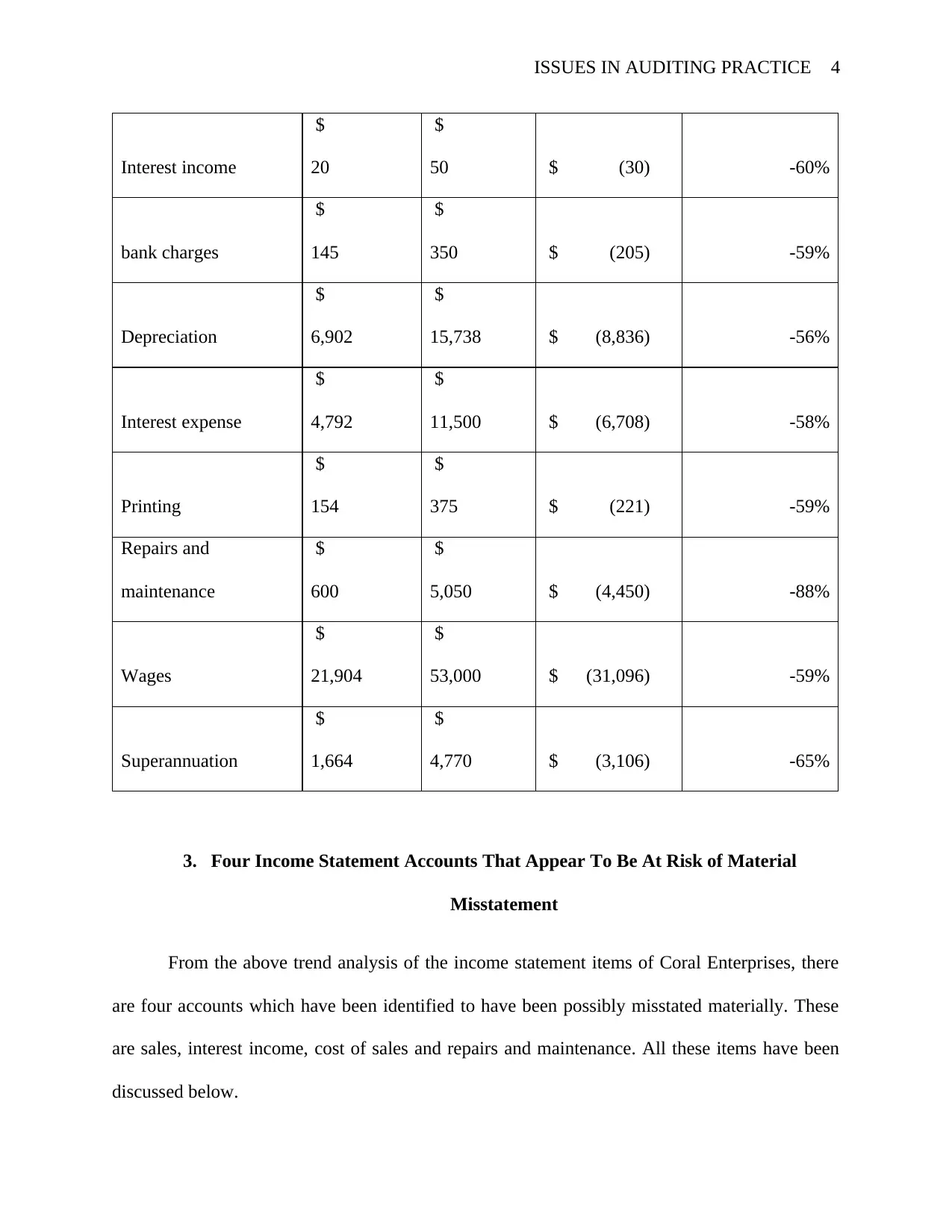
ISSUES IN AUDITING PRACTICE 4
Interest income
$
20
$
50 $ (30) -60%
bank charges
$
145
$
350 $ (205) -59%
Depreciation
$
6,902
$
15,738 $ (8,836) -56%
Interest expense
$
4,792
$
11,500 $ (6,708) -58%
Printing
$
154
$
375 $ (221) -59%
Repairs and
maintenance
$
600
$
5,050 $ (4,450) -88%
Wages
$
21,904
$
53,000 $ (31,096) -59%
Superannuation
$
1,664
$
4,770 $ (3,106) -65%
3. Four Income Statement Accounts That Appear To Be At Risk of Material
Misstatement
From the above trend analysis of the income statement items of Coral Enterprises, there
are four accounts which have been identified to have been possibly misstated materially. These
are sales, interest income, cost of sales and repairs and maintenance. All these items have been
discussed below.
Interest income
$
20
$
50 $ (30) -60%
bank charges
$
145
$
350 $ (205) -59%
Depreciation
$
6,902
$
15,738 $ (8,836) -56%
Interest expense
$
4,792
$
11,500 $ (6,708) -58%
Printing
$
154
$
375 $ (221) -59%
Repairs and
maintenance
$
600
$
5,050 $ (4,450) -88%
Wages
$
21,904
$
53,000 $ (31,096) -59%
Superannuation
$
1,664
$
4,770 $ (3,106) -65%
3. Four Income Statement Accounts That Appear To Be At Risk of Material
Misstatement
From the above trend analysis of the income statement items of Coral Enterprises, there
are four accounts which have been identified to have been possibly misstated materially. These
are sales, interest income, cost of sales and repairs and maintenance. All these items have been
discussed below.
Paraphrase This Document
Need a fresh take? Get an instant paraphrase of this document with our AI Paraphraser
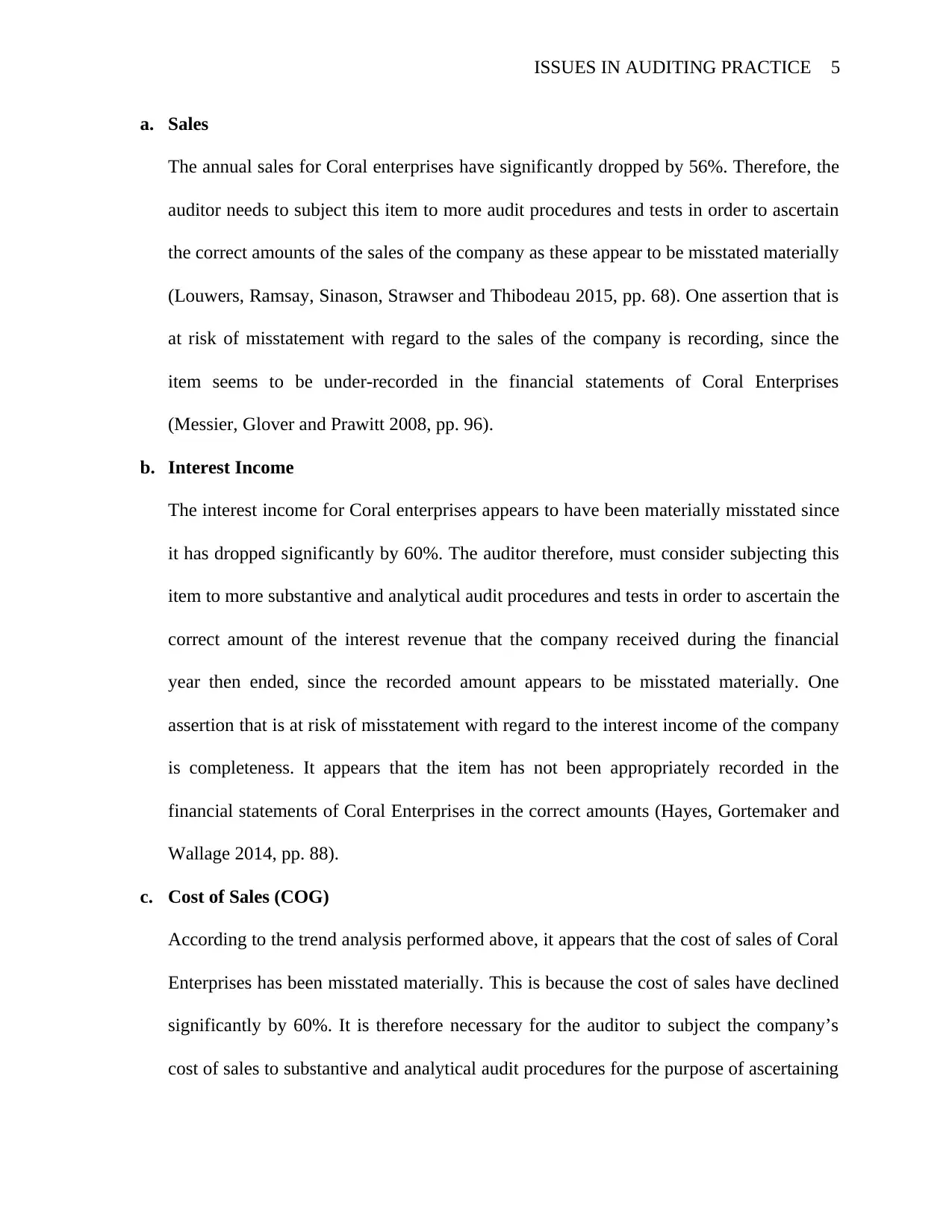
ISSUES IN AUDITING PRACTICE 5
a. Sales
The annual sales for Coral enterprises have significantly dropped by 56%. Therefore, the
auditor needs to subject this item to more audit procedures and tests in order to ascertain
the correct amounts of the sales of the company as these appear to be misstated materially
(Louwers, Ramsay, Sinason, Strawser and Thibodeau 2015, pp. 68). One assertion that is
at risk of misstatement with regard to the sales of the company is recording, since the
item seems to be under-recorded in the financial statements of Coral Enterprises
(Messier, Glover and Prawitt 2008, pp. 96).
b. Interest Income
The interest income for Coral enterprises appears to have been materially misstated since
it has dropped significantly by 60%. The auditor therefore, must consider subjecting this
item to more substantive and analytical audit procedures and tests in order to ascertain the
correct amount of the interest revenue that the company received during the financial
year then ended, since the recorded amount appears to be misstated materially. One
assertion that is at risk of misstatement with regard to the interest income of the company
is completeness. It appears that the item has not been appropriately recorded in the
financial statements of Coral Enterprises in the correct amounts (Hayes, Gortemaker and
Wallage 2014, pp. 88).
c. Cost of Sales (COG)
According to the trend analysis performed above, it appears that the cost of sales of Coral
Enterprises has been misstated materially. This is because the cost of sales have declined
significantly by 60%. It is therefore necessary for the auditor to subject the company’s
cost of sales to substantive and analytical audit procedures for the purpose of ascertaining
a. Sales
The annual sales for Coral enterprises have significantly dropped by 56%. Therefore, the
auditor needs to subject this item to more audit procedures and tests in order to ascertain
the correct amounts of the sales of the company as these appear to be misstated materially
(Louwers, Ramsay, Sinason, Strawser and Thibodeau 2015, pp. 68). One assertion that is
at risk of misstatement with regard to the sales of the company is recording, since the
item seems to be under-recorded in the financial statements of Coral Enterprises
(Messier, Glover and Prawitt 2008, pp. 96).
b. Interest Income
The interest income for Coral enterprises appears to have been materially misstated since
it has dropped significantly by 60%. The auditor therefore, must consider subjecting this
item to more substantive and analytical audit procedures and tests in order to ascertain the
correct amount of the interest revenue that the company received during the financial
year then ended, since the recorded amount appears to be misstated materially. One
assertion that is at risk of misstatement with regard to the interest income of the company
is completeness. It appears that the item has not been appropriately recorded in the
financial statements of Coral Enterprises in the correct amounts (Hayes, Gortemaker and
Wallage 2014, pp. 88).
c. Cost of Sales (COG)
According to the trend analysis performed above, it appears that the cost of sales of Coral
Enterprises has been misstated materially. This is because the cost of sales have declined
significantly by 60%. It is therefore necessary for the auditor to subject the company’s
cost of sales to substantive and analytical audit procedures for the purpose of ascertaining

ISSUES IN AUDITING PRACTICE 6
the correct amount of cost of sales for the company during the financial year then ended.
This amount seems to have been inappropriately recorded in the financial statements of
Coral Enterprises. Regarding the cost of sales for Coral Enterprises, cut off is the key
assertion which is at risk of material misstatement. It should be ensured that all costs
relating to sales have been recorded in the corresponding period during which they were
incurred (Hopwood, Leiner and Young 2011, pp. 54).
d. Repairs and Maintenance
The repairs and maintenance for Coral enterprises appear to have been materially
misstated. This because there has been a significant drop of 88% in the company’s repairs
and maintenance expenses. Therefore, the auditor must consider subjecting this item to
more audit procedures and tests with a view to ascertaining that the item has been
recorded appropriately in its correct amounts, as the amount recorded appears to be
misstated materially. One assertion which is at a risk of misstatement with regard to the
repairs and maintenance of Coral Enterprises is accuracy (Elder, Beasley and Arens 2011,
pp. 21). The amount of this income statement item appears to have been under-recorded
in the financial statements of the company (Messier, Glover and Prawitt 2008, pp. 96).
4. Audit Procedures for Each of the Above Key Assertions
There are various audit procedures which can be performed by the auditor with respect to
each of the above key assertions that are at a risk of misstatement relating to the audit of Coral
Enterprises. These audit procedures for each account have been discussed below.
a. Sales
The auditor must consider performing audit procedures that are aimed at testing for
understatement in the sales revenue reported by the company in its financial
the correct amount of cost of sales for the company during the financial year then ended.
This amount seems to have been inappropriately recorded in the financial statements of
Coral Enterprises. Regarding the cost of sales for Coral Enterprises, cut off is the key
assertion which is at risk of material misstatement. It should be ensured that all costs
relating to sales have been recorded in the corresponding period during which they were
incurred (Hopwood, Leiner and Young 2011, pp. 54).
d. Repairs and Maintenance
The repairs and maintenance for Coral enterprises appear to have been materially
misstated. This because there has been a significant drop of 88% in the company’s repairs
and maintenance expenses. Therefore, the auditor must consider subjecting this item to
more audit procedures and tests with a view to ascertaining that the item has been
recorded appropriately in its correct amounts, as the amount recorded appears to be
misstated materially. One assertion which is at a risk of misstatement with regard to the
repairs and maintenance of Coral Enterprises is accuracy (Elder, Beasley and Arens 2011,
pp. 21). The amount of this income statement item appears to have been under-recorded
in the financial statements of the company (Messier, Glover and Prawitt 2008, pp. 96).
4. Audit Procedures for Each of the Above Key Assertions
There are various audit procedures which can be performed by the auditor with respect to
each of the above key assertions that are at a risk of misstatement relating to the audit of Coral
Enterprises. These audit procedures for each account have been discussed below.
a. Sales
The auditor must consider performing audit procedures that are aimed at testing for
understatement in the sales revenue reported by the company in its financial
⊘ This is a preview!⊘
Do you want full access?
Subscribe today to unlock all pages.

Trusted by 1+ million students worldwide
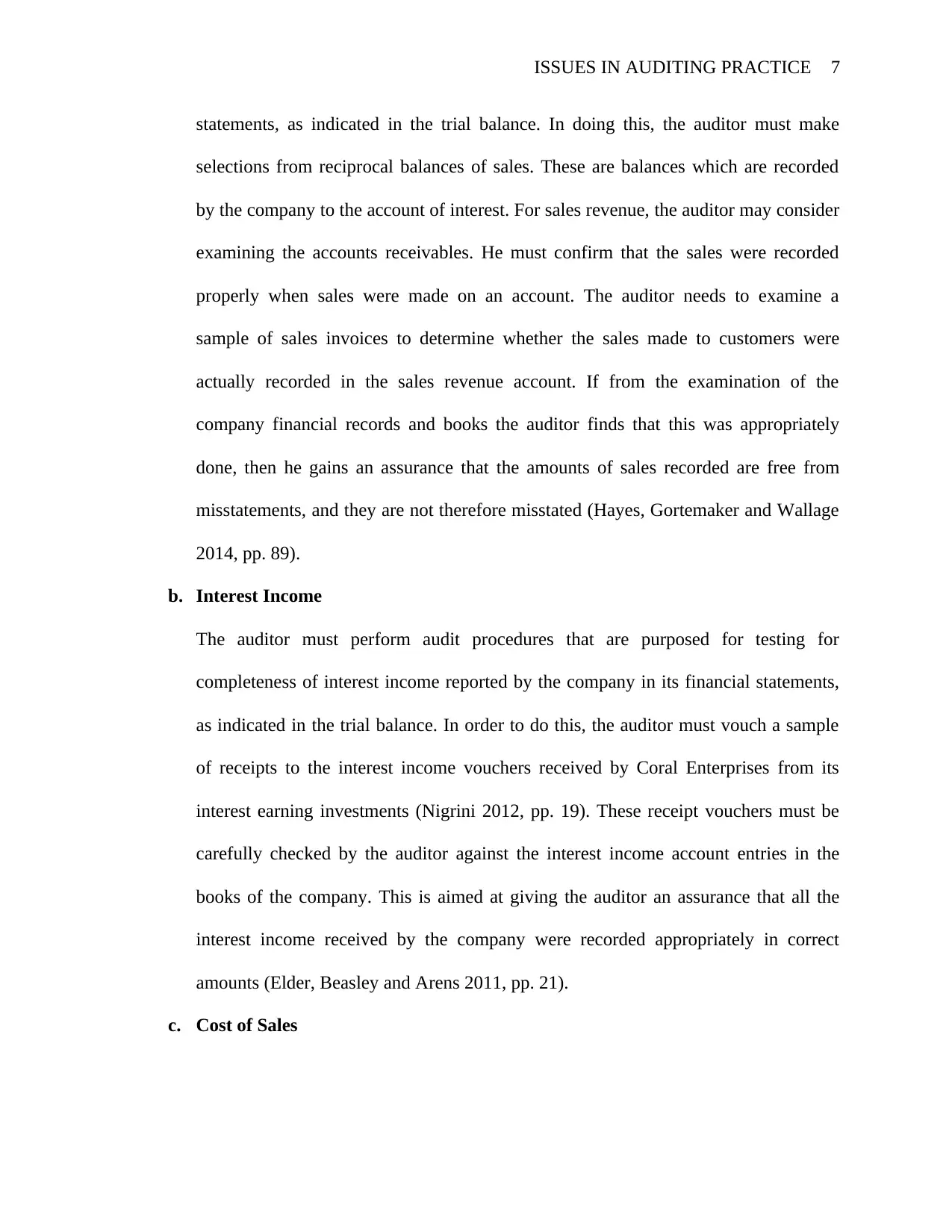
ISSUES IN AUDITING PRACTICE 7
statements, as indicated in the trial balance. In doing this, the auditor must make
selections from reciprocal balances of sales. These are balances which are recorded
by the company to the account of interest. For sales revenue, the auditor may consider
examining the accounts receivables. He must confirm that the sales were recorded
properly when sales were made on an account. The auditor needs to examine a
sample of sales invoices to determine whether the sales made to customers were
actually recorded in the sales revenue account. If from the examination of the
company financial records and books the auditor finds that this was appropriately
done, then he gains an assurance that the amounts of sales recorded are free from
misstatements, and they are not therefore misstated (Hayes, Gortemaker and Wallage
2014, pp. 89).
b. Interest Income
The auditor must perform audit procedures that are purposed for testing for
completeness of interest income reported by the company in its financial statements,
as indicated in the trial balance. In order to do this, the auditor must vouch a sample
of receipts to the interest income vouchers received by Coral Enterprises from its
interest earning investments (Nigrini 2012, pp. 19). These receipt vouchers must be
carefully checked by the auditor against the interest income account entries in the
books of the company. This is aimed at giving the auditor an assurance that all the
interest income received by the company were recorded appropriately in correct
amounts (Elder, Beasley and Arens 2011, pp. 21).
c. Cost of Sales
statements, as indicated in the trial balance. In doing this, the auditor must make
selections from reciprocal balances of sales. These are balances which are recorded
by the company to the account of interest. For sales revenue, the auditor may consider
examining the accounts receivables. He must confirm that the sales were recorded
properly when sales were made on an account. The auditor needs to examine a
sample of sales invoices to determine whether the sales made to customers were
actually recorded in the sales revenue account. If from the examination of the
company financial records and books the auditor finds that this was appropriately
done, then he gains an assurance that the amounts of sales recorded are free from
misstatements, and they are not therefore misstated (Hayes, Gortemaker and Wallage
2014, pp. 89).
b. Interest Income
The auditor must perform audit procedures that are purposed for testing for
completeness of interest income reported by the company in its financial statements,
as indicated in the trial balance. In order to do this, the auditor must vouch a sample
of receipts to the interest income vouchers received by Coral Enterprises from its
interest earning investments (Nigrini 2012, pp. 19). These receipt vouchers must be
carefully checked by the auditor against the interest income account entries in the
books of the company. This is aimed at giving the auditor an assurance that all the
interest income received by the company were recorded appropriately in correct
amounts (Elder, Beasley and Arens 2011, pp. 21).
c. Cost of Sales
Paraphrase This Document
Need a fresh take? Get an instant paraphrase of this document with our AI Paraphraser
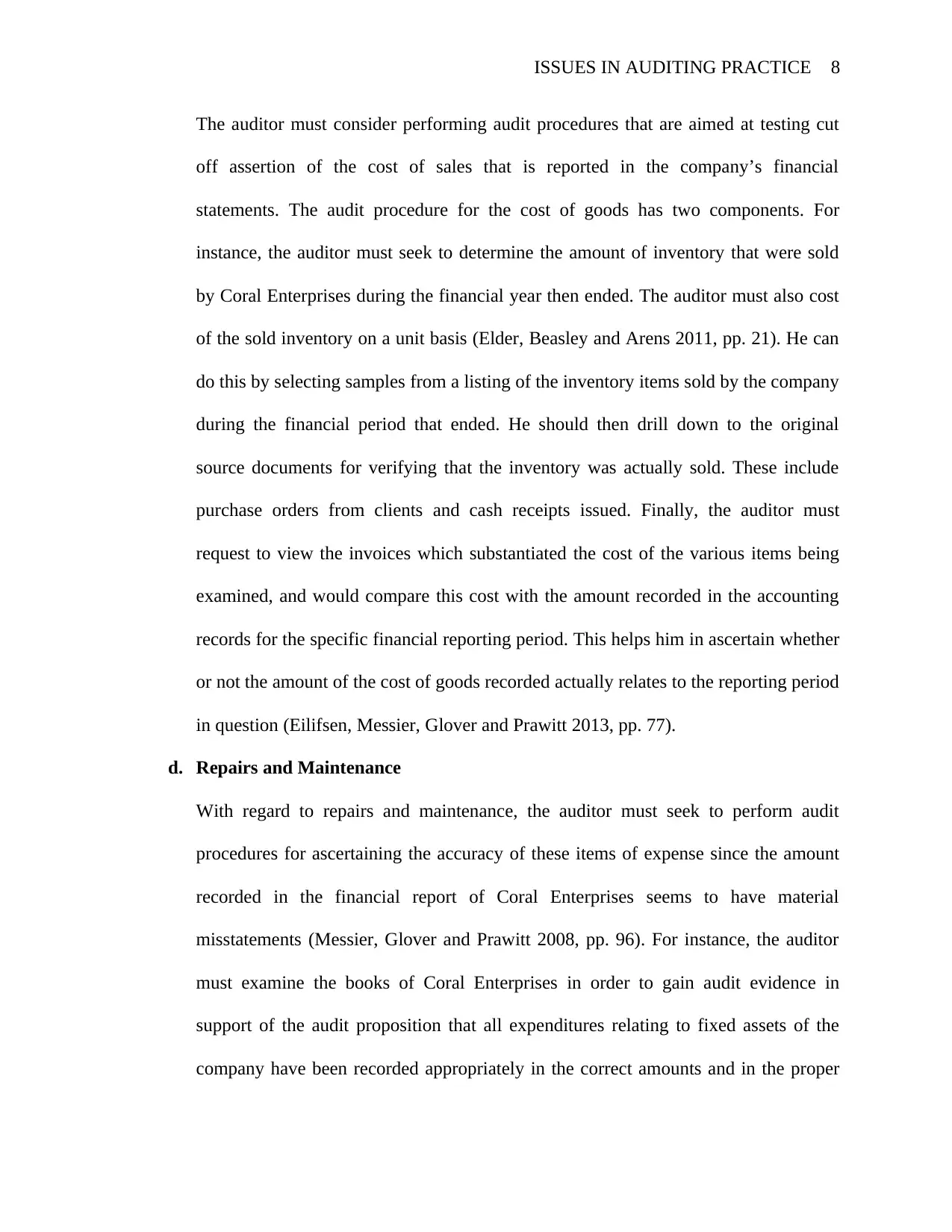
ISSUES IN AUDITING PRACTICE 8
The auditor must consider performing audit procedures that are aimed at testing cut
off assertion of the cost of sales that is reported in the company’s financial
statements. The audit procedure for the cost of goods has two components. For
instance, the auditor must seek to determine the amount of inventory that were sold
by Coral Enterprises during the financial year then ended. The auditor must also cost
of the sold inventory on a unit basis (Elder, Beasley and Arens 2011, pp. 21). He can
do this by selecting samples from a listing of the inventory items sold by the company
during the financial period that ended. He should then drill down to the original
source documents for verifying that the inventory was actually sold. These include
purchase orders from clients and cash receipts issued. Finally, the auditor must
request to view the invoices which substantiated the cost of the various items being
examined, and would compare this cost with the amount recorded in the accounting
records for the specific financial reporting period. This helps him in ascertain whether
or not the amount of the cost of goods recorded actually relates to the reporting period
in question (Eilifsen, Messier, Glover and Prawitt 2013, pp. 77).
d. Repairs and Maintenance
With regard to repairs and maintenance, the auditor must seek to perform audit
procedures for ascertaining the accuracy of these items of expense since the amount
recorded in the financial report of Coral Enterprises seems to have material
misstatements (Messier, Glover and Prawitt 2008, pp. 96). For instance, the auditor
must examine the books of Coral Enterprises in order to gain audit evidence in
support of the audit proposition that all expenditures relating to fixed assets of the
company have been recorded appropriately in the correct amounts and in the proper
The auditor must consider performing audit procedures that are aimed at testing cut
off assertion of the cost of sales that is reported in the company’s financial
statements. The audit procedure for the cost of goods has two components. For
instance, the auditor must seek to determine the amount of inventory that were sold
by Coral Enterprises during the financial year then ended. The auditor must also cost
of the sold inventory on a unit basis (Elder, Beasley and Arens 2011, pp. 21). He can
do this by selecting samples from a listing of the inventory items sold by the company
during the financial period that ended. He should then drill down to the original
source documents for verifying that the inventory was actually sold. These include
purchase orders from clients and cash receipts issued. Finally, the auditor must
request to view the invoices which substantiated the cost of the various items being
examined, and would compare this cost with the amount recorded in the accounting
records for the specific financial reporting period. This helps him in ascertain whether
or not the amount of the cost of goods recorded actually relates to the reporting period
in question (Eilifsen, Messier, Glover and Prawitt 2013, pp. 77).
d. Repairs and Maintenance
With regard to repairs and maintenance, the auditor must seek to perform audit
procedures for ascertaining the accuracy of these items of expense since the amount
recorded in the financial report of Coral Enterprises seems to have material
misstatements (Messier, Glover and Prawitt 2008, pp. 96). For instance, the auditor
must examine the books of Coral Enterprises in order to gain audit evidence in
support of the audit proposition that all expenditures relating to fixed assets of the
company have been recorded appropriately in the correct amounts and in the proper
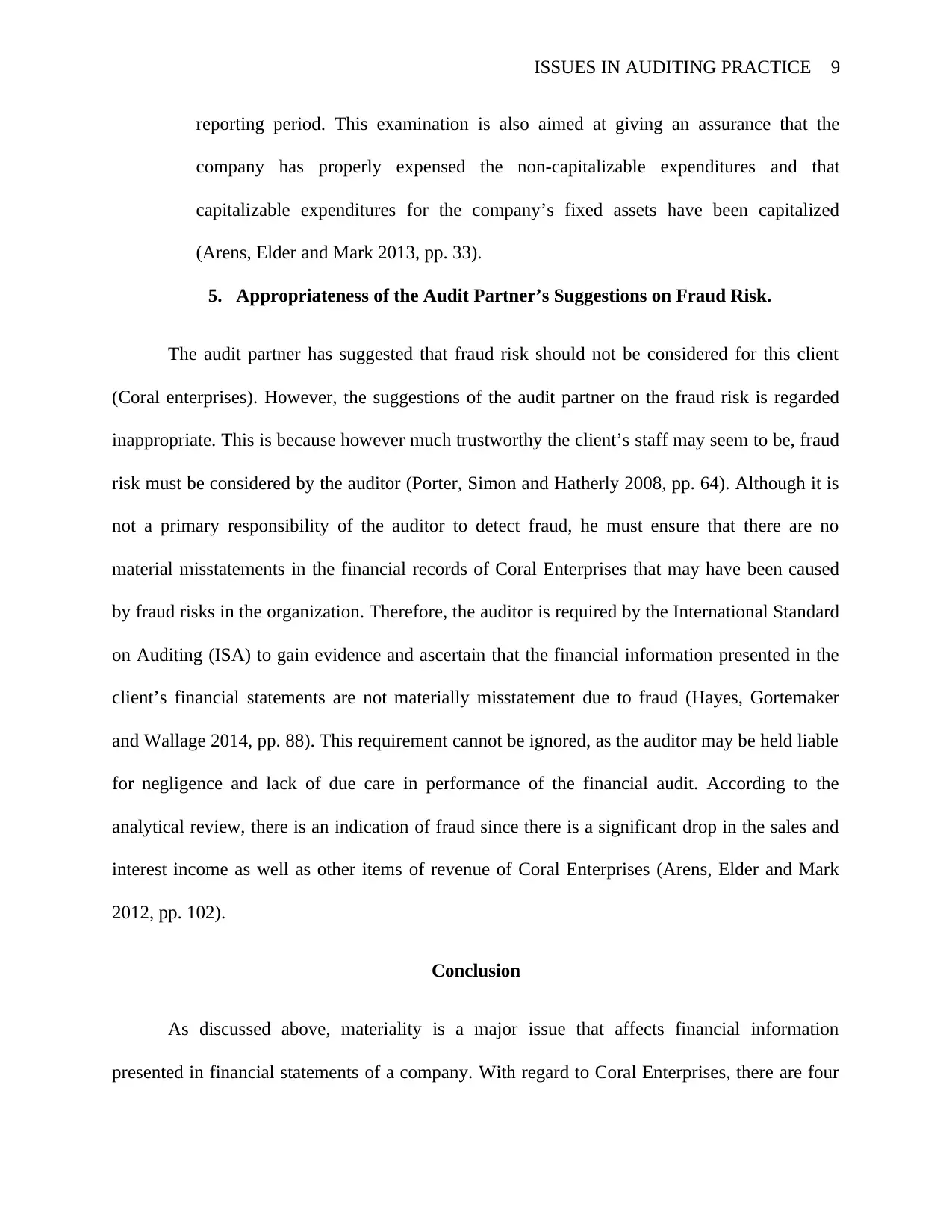
ISSUES IN AUDITING PRACTICE 9
reporting period. This examination is also aimed at giving an assurance that the
company has properly expensed the non-capitalizable expenditures and that
capitalizable expenditures for the company’s fixed assets have been capitalized
(Arens, Elder and Mark 2013, pp. 33).
5. Appropriateness of the Audit Partner’s Suggestions on Fraud Risk.
The audit partner has suggested that fraud risk should not be considered for this client
(Coral enterprises). However, the suggestions of the audit partner on the fraud risk is regarded
inappropriate. This is because however much trustworthy the client’s staff may seem to be, fraud
risk must be considered by the auditor (Porter, Simon and Hatherly 2008, pp. 64). Although it is
not a primary responsibility of the auditor to detect fraud, he must ensure that there are no
material misstatements in the financial records of Coral Enterprises that may have been caused
by fraud risks in the organization. Therefore, the auditor is required by the International Standard
on Auditing (ISA) to gain evidence and ascertain that the financial information presented in the
client’s financial statements are not materially misstatement due to fraud (Hayes, Gortemaker
and Wallage 2014, pp. 88). This requirement cannot be ignored, as the auditor may be held liable
for negligence and lack of due care in performance of the financial audit. According to the
analytical review, there is an indication of fraud since there is a significant drop in the sales and
interest income as well as other items of revenue of Coral Enterprises (Arens, Elder and Mark
2012, pp. 102).
Conclusion
As discussed above, materiality is a major issue that affects financial information
presented in financial statements of a company. With regard to Coral Enterprises, there are four
reporting period. This examination is also aimed at giving an assurance that the
company has properly expensed the non-capitalizable expenditures and that
capitalizable expenditures for the company’s fixed assets have been capitalized
(Arens, Elder and Mark 2013, pp. 33).
5. Appropriateness of the Audit Partner’s Suggestions on Fraud Risk.
The audit partner has suggested that fraud risk should not be considered for this client
(Coral enterprises). However, the suggestions of the audit partner on the fraud risk is regarded
inappropriate. This is because however much trustworthy the client’s staff may seem to be, fraud
risk must be considered by the auditor (Porter, Simon and Hatherly 2008, pp. 64). Although it is
not a primary responsibility of the auditor to detect fraud, he must ensure that there are no
material misstatements in the financial records of Coral Enterprises that may have been caused
by fraud risks in the organization. Therefore, the auditor is required by the International Standard
on Auditing (ISA) to gain evidence and ascertain that the financial information presented in the
client’s financial statements are not materially misstatement due to fraud (Hayes, Gortemaker
and Wallage 2014, pp. 88). This requirement cannot be ignored, as the auditor may be held liable
for negligence and lack of due care in performance of the financial audit. According to the
analytical review, there is an indication of fraud since there is a significant drop in the sales and
interest income as well as other items of revenue of Coral Enterprises (Arens, Elder and Mark
2012, pp. 102).
Conclusion
As discussed above, materiality is a major issue that affects financial information
presented in financial statements of a company. With regard to Coral Enterprises, there are four
⊘ This is a preview!⊘
Do you want full access?
Subscribe today to unlock all pages.

Trusted by 1+ million students worldwide
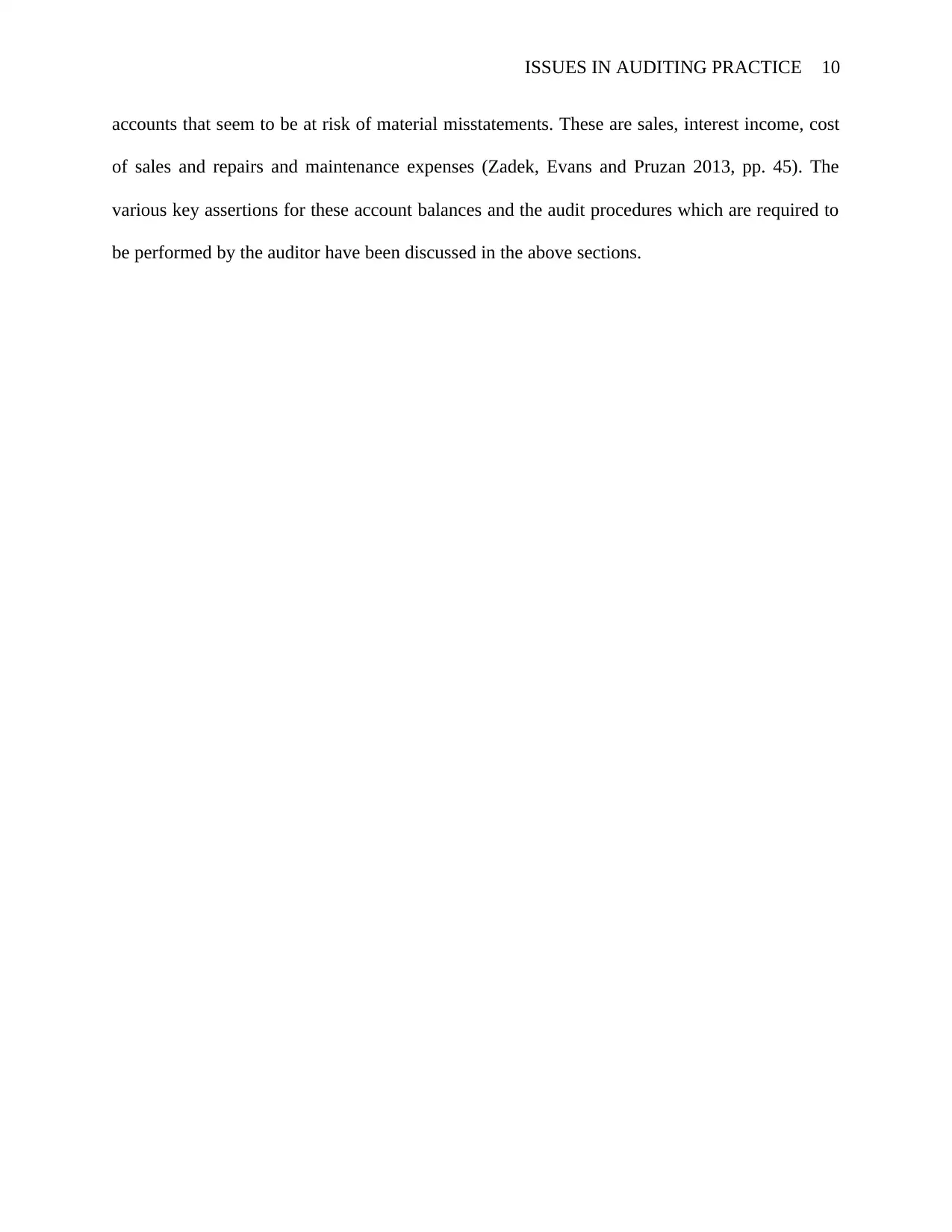
ISSUES IN AUDITING PRACTICE 10
accounts that seem to be at risk of material misstatements. These are sales, interest income, cost
of sales and repairs and maintenance expenses (Zadek, Evans and Pruzan 2013, pp. 45). The
various key assertions for these account balances and the audit procedures which are required to
be performed by the auditor have been discussed in the above sections.
accounts that seem to be at risk of material misstatements. These are sales, interest income, cost
of sales and repairs and maintenance expenses (Zadek, Evans and Pruzan 2013, pp. 45). The
various key assertions for these account balances and the audit procedures which are required to
be performed by the auditor have been discussed in the above sections.
Paraphrase This Document
Need a fresh take? Get an instant paraphrase of this document with our AI Paraphraser

ISSUES IN AUDITING PRACTICE 11
Bibliography
Arens, A.A., Elder, R.J. and Mark, B., 2012. Auditing and assurance services: an integrated
approach. Boston: Prentice Hall.
Arens, A.A., Elder, R.J. and Mark, B., 2013. Auditing and assurance services. Pearson Higher
Ed.
Eilifsen, A., Messier, W.F., Glover, S.M. and Prawitt, D.F., 2013. Auditing and assurance
services. McGraw-Hill.
Elder, R.J., Beasley, M.S. and Arens, A.A., 2011. Auditing and Assurance services. Pearson
Higher Ed.
Hayes, R.S., Gortemaker, H. and Wallage, P., 2014. Principles of auditing: an introduction to
international standards on auditing. Prentice Hall, Financial Times.
Hopwood, W.S., Leiner, J.J. and Young, G.R., 2011. Forensic accounting and fraud
examination. McGraw-Hill.
Louwers, T.J., Ramsay, R.J., Sinason, D.H., Strawser, J.R. and Thibodeau, J.C., 2015. Auditing
& assurance services. McGraw-Hill Education.
Messier, W.F., Glover, S.M. and Prawitt, D.F., 2008. Auditing & assurance services: A
systematic approach. Boston, MA: McGraw-Hill Irwin.
Bibliography
Arens, A.A., Elder, R.J. and Mark, B., 2012. Auditing and assurance services: an integrated
approach. Boston: Prentice Hall.
Arens, A.A., Elder, R.J. and Mark, B., 2013. Auditing and assurance services. Pearson Higher
Ed.
Eilifsen, A., Messier, W.F., Glover, S.M. and Prawitt, D.F., 2013. Auditing and assurance
services. McGraw-Hill.
Elder, R.J., Beasley, M.S. and Arens, A.A., 2011. Auditing and Assurance services. Pearson
Higher Ed.
Hayes, R.S., Gortemaker, H. and Wallage, P., 2014. Principles of auditing: an introduction to
international standards on auditing. Prentice Hall, Financial Times.
Hopwood, W.S., Leiner, J.J. and Young, G.R., 2011. Forensic accounting and fraud
examination. McGraw-Hill.
Louwers, T.J., Ramsay, R.J., Sinason, D.H., Strawser, J.R. and Thibodeau, J.C., 2015. Auditing
& assurance services. McGraw-Hill Education.
Messier, W.F., Glover, S.M. and Prawitt, D.F., 2008. Auditing & assurance services: A
systematic approach. Boston, MA: McGraw-Hill Irwin.
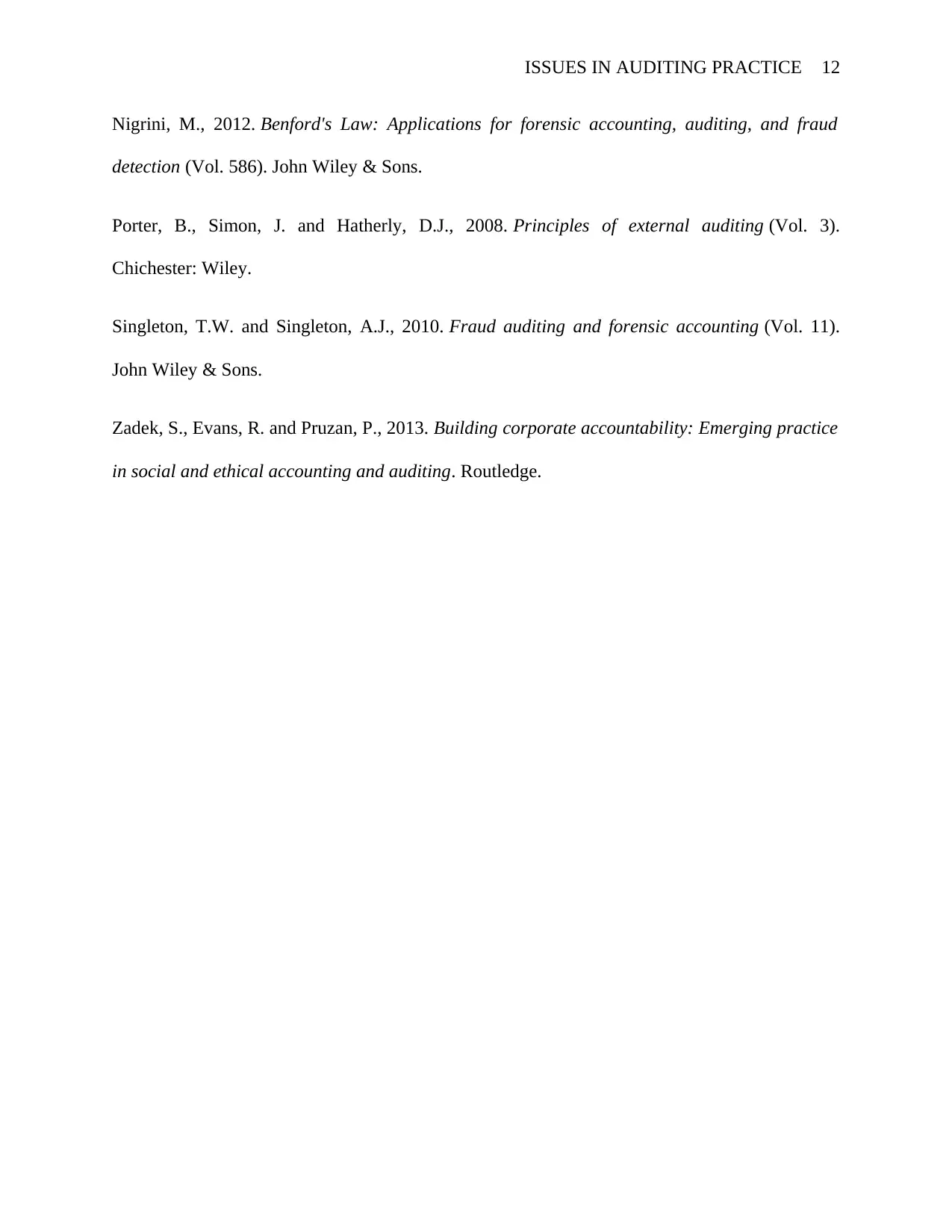
ISSUES IN AUDITING PRACTICE 12
Nigrini, M., 2012. Benford's Law: Applications for forensic accounting, auditing, and fraud
detection (Vol. 586). John Wiley & Sons.
Porter, B., Simon, J. and Hatherly, D.J., 2008. Principles of external auditing (Vol. 3).
Chichester: Wiley.
Singleton, T.W. and Singleton, A.J., 2010. Fraud auditing and forensic accounting (Vol. 11).
John Wiley & Sons.
Zadek, S., Evans, R. and Pruzan, P., 2013. Building corporate accountability: Emerging practice
in social and ethical accounting and auditing. Routledge.
Nigrini, M., 2012. Benford's Law: Applications for forensic accounting, auditing, and fraud
detection (Vol. 586). John Wiley & Sons.
Porter, B., Simon, J. and Hatherly, D.J., 2008. Principles of external auditing (Vol. 3).
Chichester: Wiley.
Singleton, T.W. and Singleton, A.J., 2010. Fraud auditing and forensic accounting (Vol. 11).
John Wiley & Sons.
Zadek, S., Evans, R. and Pruzan, P., 2013. Building corporate accountability: Emerging practice
in social and ethical accounting and auditing. Routledge.
⊘ This is a preview!⊘
Do you want full access?
Subscribe today to unlock all pages.

Trusted by 1+ million students worldwide
1 out of 12
Related Documents
Your All-in-One AI-Powered Toolkit for Academic Success.
+13062052269
info@desklib.com
Available 24*7 on WhatsApp / Email
![[object Object]](/_next/static/media/star-bottom.7253800d.svg)
Unlock your academic potential
Copyright © 2020–2025 A2Z Services. All Rights Reserved. Developed and managed by ZUCOL.




